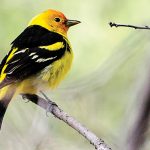In October’s honeyed light, one learns to look for these exquisite travelers
Story & Photograph by Virginia Holman
October at the coast: The tourists have left, and the fishermen have arrived. They line the long piers that jut into the ocean and spend days catching spot and blue — whatever’s running. The blue avoid large shadows. They’ll approach the pier, but stop short and swerve around the presence of the giant predator, which — with all those fishermen dangling their baited hooks from above — it most assuredly is.
By this time of year, the worst of hurricane season has passed, though the risk always lurks — one can spring up out of nowhere at any time — day by day, the chance lessens. The autumn sun drops; the Earth tilts. Of course, the days have been growing shorter since late June, but I never truly notice it until October, when the light grows dense and honeyed. I rush out most evenings just after the sun has slipped away because in October, it’s followed by purple nimbus that seems to hover above the water and then slowly paints the sky.
Different tourists arrive. Tree swallows swoop in, chattering in the wax myrtles near the dunes. In a sudden rush, with an audible whoosh, they rise from the trees in a dark cloud cast forth like a sorcerer’s spell. They swirl as one, pulsing and contracting in a display not unlike the bluefish.
On my evening walk last year, I came across a lone swallow. It was resting in the sand. It seemed strange, alone like that. Vulnerable. But it wasn’t. Aware of my presence, it lifted back into the sky, absorbed into the flock.
***
I can’t recall the first time I noticed the Monarchs in autumn — or even when I became aware of butterfly migration as something happening around me. I suppose it was when I started kayaking and was outside more. Occasionally a butterfly would stop on my bow for a bit, hitching a ride as I paddled across the water.
There’s something magisterial about a Monarch in flight. Its wingbeats seem comparatively languid when compared to other butterflies. Their color is autumn light distilled to a saffron orange, the same vibrant color of the robes worn by Theravadan Buddhist monks. Their black-veined wings are reminiscent of the lead joinery between panes of stained glass. Sometimes two Monarchs fly past, clasped in their long mating, one seeming to carry the other through the air.
I suppose, from some back-of-the-mind place, I recalled a National Geographic photo of a woman covered in Monarchs, so I knew that many migrate to Mexico, but I did not know that the Monarchs often arrive around the Day of the Dead, a time when many people believe the curtain is parted between the living world and the afterlife, and souls can travel freely. Some people believe these butterflies are their departed loved ones, transfigured.
Yet it wasn’t until I stumbled upon Monarch roosts in coastal North Carolina that I truly understood their migration. Unlike swallows or bluefish, they don’t travel together. Rather, they travel alone, at their own pace, but meet up in the evenings. No one knows why exactly. I’ve been fortunate enough to see six or seven roosts over the last 10 years, and I’ve gotten better at guessing when they’ll arrive in the fall. You just have to be on the lookout. Learn what types of trees they like (cedars are desirable, as are wax myrtle) or whether you tend to see them when it’s dry or after a long hard rain.
Since I’ve been looking, I’ve been fortunate enough to see hundreds, perhaps a thousand, huddled together, readying for a cold night. (Bald Head Island is a good place to look.) If the wind is still, you can hear the movement of their wings, like a rustle. If the wind is up, pay attention to how the butterflies can navigate through the current with visible precision, rather than being buffeted helplessly about.
If you spy a Monarch roost, you’ll notice it looks like slow-motion flames dancing atop a wax myrtle or cedar. Then night falls, and the Monarchs close their wings, concealing their fire, showing only their drab underside, and all at once they vanish. To the casual walker, they appear as nothing more than dry leaves on a vine.
Last fall I saw a roost. The next evening, I returned to the same spot, hoping to see the Monarchs again, but they were long gone. Later, I read they routinely travel 50 miles a day, more if the wind is with them. Many travel over 3,000 miles to reach their overwintering grounds in Mexico. Miss them when they pass through, and you’re flat out of luck until next year.
If you’re like me, when you begin to find them, all your eyes will want to see are Monarchs. That leaf at the top of the cedar, no. The shadows beneath the bough, no. The motion across the field? Perhaps. Often, giddy with Monarch-mania, I am fooled, and laugh at my inexpert identification skills again and again. Yet, how wonderful that, in a single walk, a single afternoon of watching Monarchs, the brain trains itself to search for them everywhere, even where they cannot be, because, just maybe, there will be one someplace surprising, and the seer will experience joy and beauty once again.
Author Virginia Holman, a regular Salt columnist, teaches in the creative writing department at UNC Wilmington and occasionally guides with Kayak Carolina.


